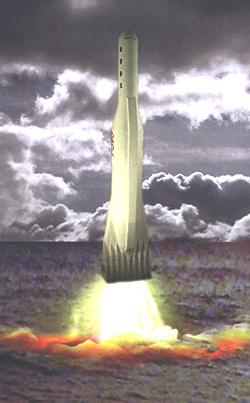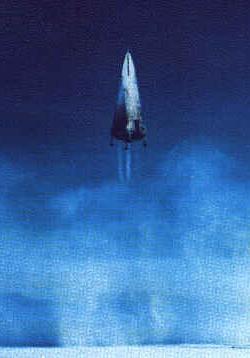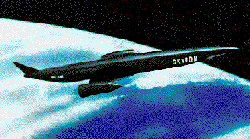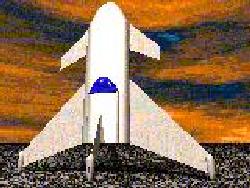| A sea-launched sub-orbital
VTOHL |
 |
 |
Technology
Thursday 8 November 2012
CAC-1
DELTA CLIPPER (DC-X, DC-XA, CLIPPER GRAHAM)
The Delta Clipper was a proposed
VTOL
was a proposed
VTOL orbital vehicle. The DC-X
orbital vehicle. The DC-X and later DC-XA
and later DC-XA (derived from the DC-X
(derived from the DC-X ) were low-speed, reusable test-vehicles built by
McDonnell Douglas
) were low-speed, reusable test-vehicles built by
McDonnell Douglas which flew 12 times between 1993-96, until suffering major fire damage
after falling over when a leg failed to deploy on landing. On a total
budget of about $100 million provided mainly by the US Department of
Defense (DoD) and
McDonnell Douglas
which flew 12 times between 1993-96, until suffering major fire damage
after falling over when a leg failed to deploy on landing. On a total
budget of about $100 million provided mainly by the US Department of
Defense (DoD) and
McDonnell Douglas Aerospace, they demonstrated that reusable rocket vehicles can be flown
repeatedly and routinely by a small team - essentially like an
aircraft.
Aerospace, they demonstrated that reusable rocket vehicles can be flown
repeatedly and routinely by a small team - essentially like an
aircraft.
Having inherited the project from the DoD, NASA cancelled it after spending some $40 million. Instead, NASA
cancelled it after spending some $40 million. Instead, NASA spent $1,300 million over 5 years on the
X-33
spent $1,300 million over 5 years on the
X-33 and
X-34
and
X-34 , neither of which ever flew before being cancelled. Go figure!
, neither of which ever flew before being cancelled. Go figure!
It's notable that, apart from its computers, the DC-X could have been built 30 years earlier - and indeed a proposal for such
a vehicle was made at that time by the Douglas company, a fore-runner
of McDonnell-Douglas. Why it wasn't built, and why NASA
could have been built 30 years earlier - and indeed a proposal for such
a vehicle was made at that time by the Douglas company, a fore-runner
of McDonnell-Douglas. Why it wasn't built, and why NASA cancelled the the DC-XA
cancelled the the DC-XA , are key to the stagnation in the space industry.
, are key to the stagnation in the space industry.

Having inherited the project from the DoD, NASA
It's notable that, apart from its computers, the DC-X

SPACE VAN
The Space Van is designed to carry 16 passengers plus a flight crew of 3 to
LEO
is designed to carry 16 passengers plus a flight crew of 3 to
LEO .
A reusable booster stage accelerates the orbiter to around mach 3 at
30km altitude; the relatively low velocity compared to other booster
designs allows a simpler and less complex design. Proposed by Space Tour
.
A reusable booster stage accelerates the orbiter to around mach 3 at
30km altitude; the relatively low velocity compared to other booster
designs allows a simpler and less complex design. Proposed by Space Tour , an unmanned cargo carrying variant is also on the drawing board.
, an unmanned cargo carrying variant is also on the drawing board.


SKYLON
SKYLON is the successor to
HOTOL being developed by Reaction Engines
being developed by Reaction Engines Ltd. It is an unpiloted fully reusable aircraft-like vehicle capable of
transporting 12 tonnes of cargo into space and is intended as a
replacement for expensive expendable launchers in the commerical market.
Ltd. It is an unpiloted fully reusable aircraft-like vehicle capable of
transporting 12 tonnes of cargo into space and is intended as a
replacement for expensive expendable launchers in the commerical market.


POGO
As an example of how airbreathing engines could be used, the
Pogo is intended as the first stage of a
TSTO
is intended as the first stage of a
TSTO or MSTO launch system. Shown here using existing jet engines from the
F-15 it is expected to reach at least Mach 2.5 and 80,000 ft before
releasing a Pegasus-sized vehicle. Jet engines being developed for a
proposed hypersonic commercial transport ("Hypersonic Transport
Propulsion," Aerospace Engineering, June 1996, pp
7-11.) could take a much larger Pogo
or MSTO launch system. Shown here using existing jet engines from the
F-15 it is expected to reach at least Mach 2.5 and 80,000 ft before
releasing a Pegasus-sized vehicle. Jet engines being developed for a
proposed hypersonic commercial transport ("Hypersonic Transport
Propulsion," Aerospace Engineering, June 1996, pp
7-11.) could take a much larger Pogo to Mach 5 and 100,000 ft. For many payload sizes, low-cost jet engines
can do the job of rockets in the region where rockets are most
expensive and inefficient.
to Mach 5 and 100,000 ft. For many payload sizes, low-cost jet engines
can do the job of rockets in the region where rockets are most
expensive and inefficient.


SPACE CRUISER SYSTEM ®
|
SCS Zegrahm ultimately expects to be able to fly two flights a week whilst the vehicles are being designed to be capable of upto two flights a day. Space Cruiser ® and Sky Lifter ® are registered trademarks of Vela Technology Development, Inc. |
|
 |
Subscribe to:
Posts (Atom)
